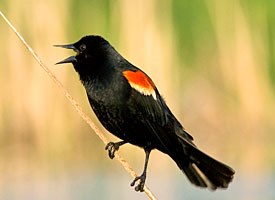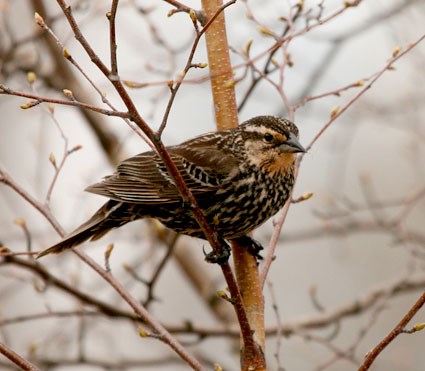By the time we resume our Sunday hikes, after a week’s hiatus, it should be warm enough for our songbirds to return from their winter residences, and begin planning the production of another generation.
 For most birds, both genders return together. One notable exception is the redwinged blackbird, a common inhabitant of our wetlands. The cock is one of the first birds to return. We should be able to see, and hear them, in wet areas. The hens return a few weeks later and, by then, the cocks have established a breeding territory, and are singing to notify the hens of their presence. After she finds a cock who’se attractive to her, a brief courtship procedure seals the bond, and serious nest building begins.
For most birds, both genders return together. One notable exception is the redwinged blackbird, a common inhabitant of our wetlands. The cock is one of the first birds to return. We should be able to see, and hear them, in wet areas. The hens return a few weeks later and, by then, the cocks have established a breeding territory, and are singing to notify the hens of their presence. After she finds a cock who’se attractive to her, a brief courtship procedure seals the bond, and serious nest building begins.
 Birds can be monomorphic (one form), where both genders look alike, or dimorphic (2 forms), where the genders have different plumage. The redwinged blackbird is a good example of the latter. The cock’s feathers are jet black, except for a red spot on his wing, with a yellow border, which gives this bird its name. The hen is a mottled brown.
Birds can be monomorphic (one form), where both genders look alike, or dimorphic (2 forms), where the genders have different plumage. The redwinged blackbird is a good example of the latter. The cock’s feathers are jet black, except for a red spot on his wing, with a yellow border, which gives this bird its name. The hen is a mottled brown.
The redwinged blackbird, and many other birds, are always dimorphic. Some, just during the breeding season. As the cock molts his feathers during the summer, by fall, he looks just like the hen, as in some warblers. Others may be very subtly dimorphic, the familiar robin being a good example. The feathers, on the cock’s head, are a very slightly darker shade of grey, than those on his back. The hen’s head featherss are the same as her back. See if you can tell the difference, when you see them.
Because the cocks are decked out in their colorful breeding plumage, and are singing their unique songs to attract hens, the next 2 months are the best time to learn birds. On the naturalist hikes, we will try to identify the birds we encounter, by sight and sound, and make a list for each hike. While birds are less active in mid afternoon, we should still be able to find some.
